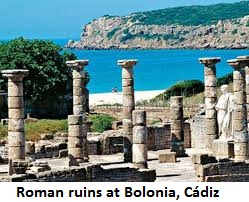Spanish
is a Romance language, meaning that
it is a vernacular descendant of Latin, the official language of the Roman Empire. In addition to Spanish, the Romance group includes such
national languages as Portuguese, French, Italian, and Rumanian, as well as
regional languages and dialects like Catalan, Galician, Occitan, Rheto-Romance
and Sardinian. Latin is normally thought of as an extinct language, and in one
sense this is true, as there  are no longer any native speakers of the Classical
Latin that is taught in schools. On the other hand, each of the languages that
were just mentioned could be regarded as regional varieties of modern Latin.
The fact that modern Spanish or French speakers, for example, cannot understand
Classical Latin (unless they have deliberately learned it) reveals the far
reaching changes that have taken place as the Romance languages have evolved.
Nevertheless, an unbroken chain of speakers exists that links the population of
the Roman Empire with the present population of the Romance-speaking world.
are no longer any native speakers of the Classical
Latin that is taught in schools. On the other hand, each of the languages that
were just mentioned could be regarded as regional varieties of modern Latin.
The fact that modern Spanish or French speakers, for example, cannot understand
Classical Latin (unless they have deliberately learned it) reveals the far
reaching changes that have taken place as the Romance languages have evolved.
Nevertheless, an unbroken chain of speakers exists that links the population of
the Roman Empire with the present population of the Romance-speaking world.
Like the other Romance languages, Spanish is derived from Vulgar Latin, the complex of dialects that represented the language spoken by legionaries, traders, farmers and so forth. Concrete evidence of what Vulgar Latin was like is hard to come by, however, as it was never systematically written down. As the philologist Menéndez Pidal put it (1968:3), el cantero más rudo, al grabar un letrero, se proponía escribir la lengua clásica ‘the least polished stone mason, when he carved a sign, tried to write the classical language.’ Only in a handful of inscriptions, prescriptive treatises such as the famous Appendix Probi, and the occasional non-standard text are we given a glimpse of how Latin was actually spoken by the population at large.
Nevertheless, the gap between Vulgar and Classical Latin should not be overestimated. It is true that grammatical relations which in Classical Latin were expressed by inflecting individual words were more commonly represented in the Vulgar variety syntactically or periphrastically, as in de cervos for cervorum ‘of the deer’ or cantare habeo for cantabo ‘I will sing’. But there is no reason to suppose that the bulk of the populace would have been incapable of recognizing most of the words of a Classical text when it was read aloud or even of decoding the literary syntax and morphology.
Vulgar Latin was presumably always subject to considerable
geographical variation, although not to the extent that Latin
speakers from different parts of the Empire would not have been able to
understand one another. Regional varieties gradually drifted apart, a process
that can only have accelerated after the
Spanish has its roots in the rustic Latin of southern
Cantabria and its growth from obscure provincial dialect to world language
mirrors the rise of the
References
Gifford, D. J. and F. W. Hodcroft. 1966. Textos Linguisticos de Medioevo Espanol. Con Introducciones y Glosario. London: Dolphin Book Co.
Menéndez Pidal, Ramón. 1968. Manual de gramática histórica español. Madrid: Espasa Calpe.